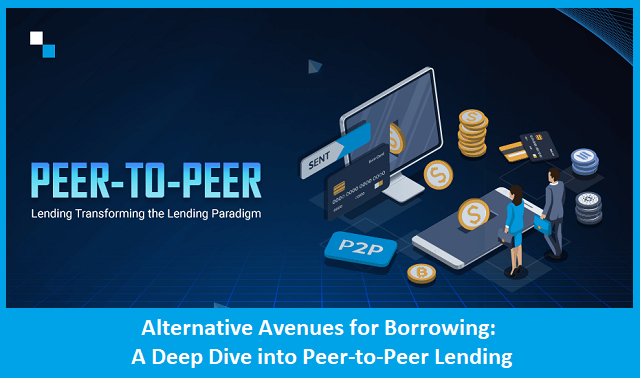Introduction:
In recent times, peer-to-peer (P2P) lending has risen as a popular alternative to conventional borrowing methods. Also termed marketplace lending, P2P lending facilitates direct connections between borrowers and individual investors through online platforms, sidestepping traditional financial institutions like banks and credit unions. This innovative lending approach presents numerous advantages for both borrowers and investors, offering access to financing options that are often more flexible, affordable, and accessible than traditional loans. In this thorough guide, we’ll navigate through the realm of peer-to-peer lending, scrutinizing its mechanics, weighing its pros and cons, and providing insights for borrowers seeking alternative funding sources.

Understanding Peer-to-Peer Lending:
Peer-to-peer lending platforms serve as intermediaries that pair borrowers with investors eager to fund their loans. Borrowers submit loan applications detailing their financial needs, credit history, and loan objectives, which are then assessed and sanctioned by the P2P platform. Once approved, the loan request is showcased on the platform’s marketplace, where investors can peruse the borrower’s profile and loan particulars, deciding whether to contribute to the loan in part or in full.
How Peer-to-Peer Lending Works:
1. Borrower Application: Borrowers initiate the process by applying for loans through P2P lending platforms, furnishing pertinent financial details such as income, employment history, credit score, and loan purpose via an online application.
2. Loan Listing: Upon approval of the borrower’s application, the loan request is listed on the P2P platform’s marketplace. Investors then browse available loans, selecting those aligning with their risk tolerance and investment objectives.
3. Funding Process: Investors evaluate the borrower’s profile, loan specifics, and the platform’s credit risk assessment before opting to fund the loan. Investors can contribute varying amounts, diversifying their investment portfolio across multiple loans to mitigate risk.
4. Loan Origination: Once the loan garners full funding from investors, the borrower receives the loan proceeds directly deposited into their bank account. Subsequently, the borrower repays the loan through fixed monthly installments, encompassing principal and interest, over the loan term.
5. Loan Servicing: P2P lending platforms typically manage loan servicing tasks, including collecting payments from borrowers, disbursing payments to investors, and overseeing borrower communications throughout the loan tenure.
Advantages of Peer-to-Peer Lending:
- Accessibility: P2P lending extends financing access to individuals encountering hurdles in securing loans through traditional financial channels, be it due to limited credit history, past credit challenges, or unconventional borrowing requirements.
- Lower Interest Rates: Peer-to-peer loans may offer lower interest rates compared to conventional loans, particularly for borrowers boasting favorable credit scores and robust financial profiles. Eliminating intermediaries like banks allows P2P lending platforms to pass on cost savings to borrowers in the form of reduced interest rates.
- Flexible Loan Terms: P2P lending platforms frequently present flexible loan terms, permitting borrowers to tailor loan amounts, repayment schedules, and loan durations to suit their financial preferences and requirements.
- Quick Approval Process: The online application and approval process for peer-to-peer loans typically boast swifter turnaround times compared to traditional loan applications, with many borrowers securing funding within days of loan approval.
- Diverse Funding Sources: Peer-to-peer lending furnishes borrowers with access to a diverse pool of investors, spanning individual investors, institutional investors, and hedge funds, who may be inclined to fund loans overlooked by traditional lenders.
Considerations for Borrowers:
While peer-to-peer lending offers manifold benefits, borrowers should carefully weigh the following factors before opting for a P2P loan:
- Creditworthiness: Your credit score and financial track record wield substantial influence over your eligibility for a peer-to-peer loan and the interest rate you qualify for. Borrowers boasting higher credit scores stand a better chance of securing lower interest rates and more favorable loan terms.
- Loan Purpose: P2P lending platforms may impose constraints on the types of loans they extend, with some platforms specializing in specific loan purposes such as debt consolidation, home improvement, or small business funding. Select a platform aligning with your borrowing needs and loan objectives.
- Fees and Charges: Peer-to-peer loans may be subject to origination fees, late payment penalties, and other charges, which can impact the overall cost of borrowing. Scrutinize the fee structure of the P2P platform diligently and factor these costs into your loan deliberation.
- Risk of Default: As with any form of lending, peer-to-peer loans carry the risk of default. While P2P lending platforms conduct credit checks and risk assessments on borrowers, there remains the possibility of borrowers defaulting on their loan obligations, potentially resulting in financial losses for investors.
- Marketplace Dynamics: The availability of peer-to-peer loans and prevailing interest rates may fluctuate based on market dynamics, investor demand, and platform policies. Be prepared for potential fluctuations in loan availability and interest rates over time.
Conclusion:
Peer-to-peer lending offers a progressive and accessible alternative to traditional borrowing avenues, furnishing borrowers with flexible financing options and investors with opportunities to diversify their investment portfolios. By comprehending the mechanics of peer-to-peer lending, assessing its merits and demerits, and considering pertinent factors for borrowers, you can make well-informed decisions regarding the suitability of P2P lending for your borrowing requirements. Whether you seek to consolidate debt, finance a significant purchase, or fund a business endeavor, peer-to-peer lending may present a viable avenue to help you realize your financial aspirations.
